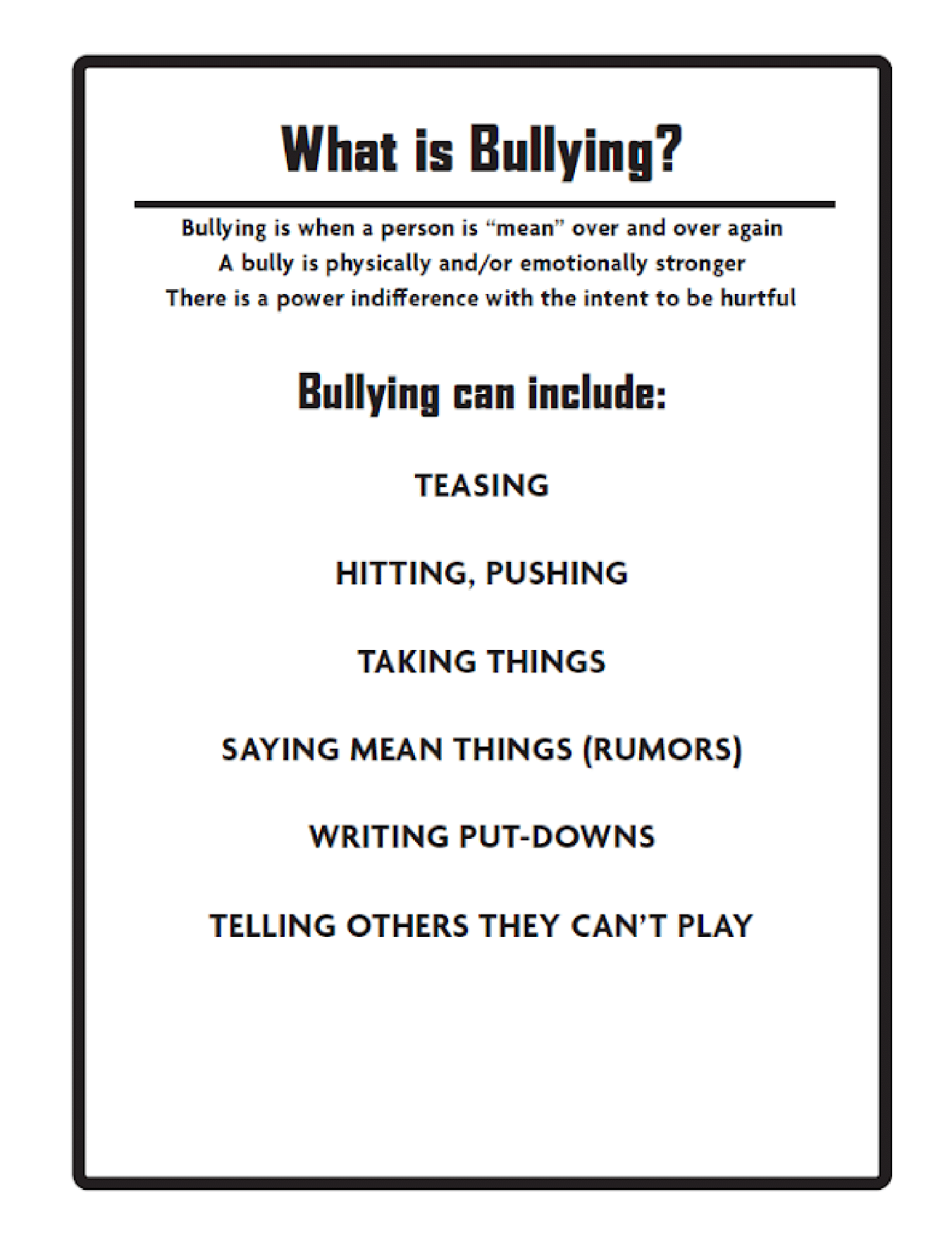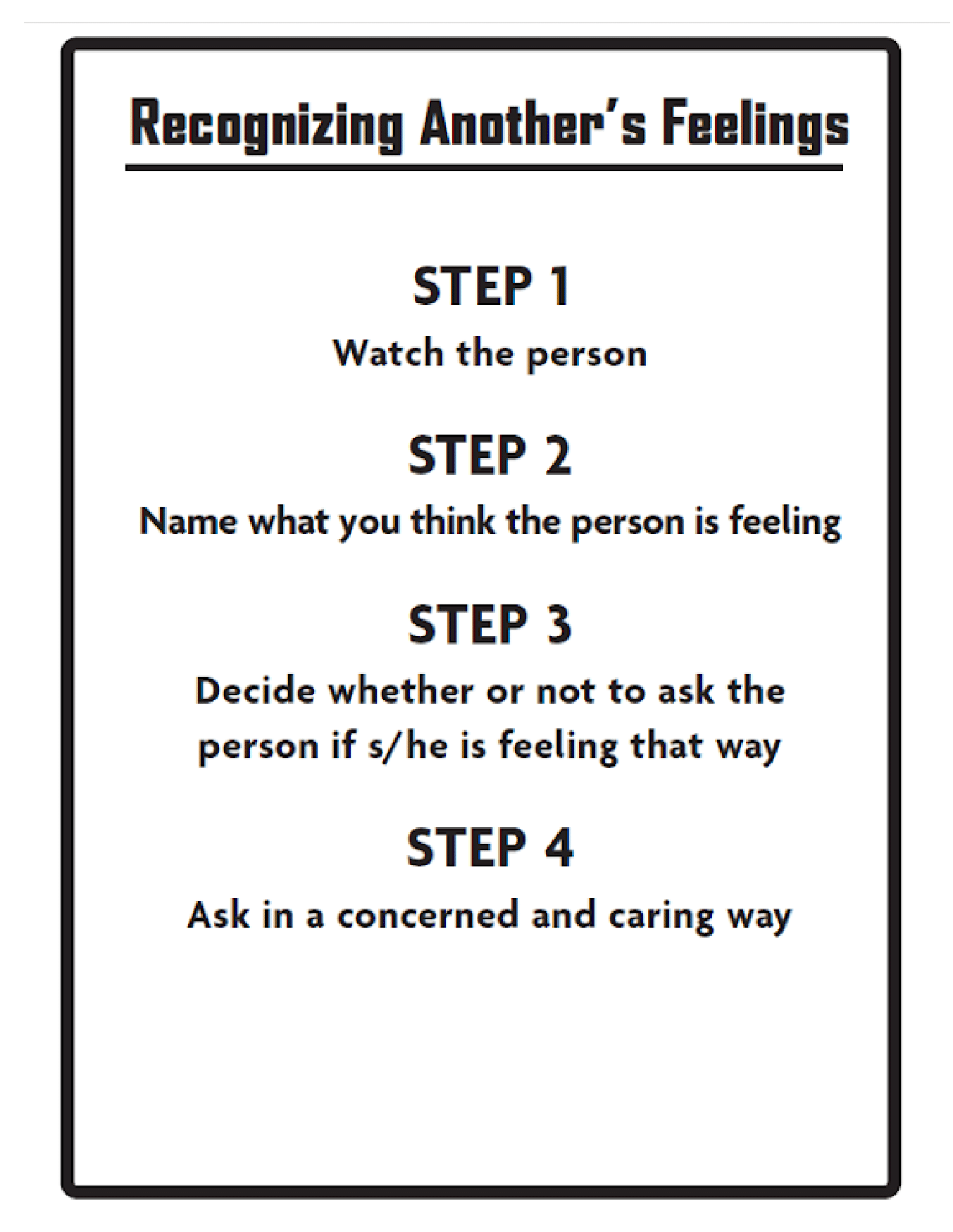Hey, Little Ant – Activity #2: “Bullying 101”
Activity #2: “Bullying 101”
This activity introduces specific concepts of bullying. Students review the steps to recognizing another person’s feelings, including what bullying looks like.
Materials:
- Chart Paper
- Felt Pen
- What Is Bullying? poster (provided)
- Feeling cards (from Activity #1)
- Recognizing Another Person’s Feelings chart (provided)
Teacher Preparation:
- Enlarge/create the What Is Bullying? poster for the students to review.
- Enlarge/create the Recognizing Another Person’s Feelings chart.
Step by Step:
Step One: Give a lesson about bullying. Ask the students if they thought that the kid in the story could be considered a bully and if so, why.
What is Bullying?
Explain the definition of bullying. It must include all 3 to be considered bullying:
- bullying is when a person is “mean” over and over again
- bullying involves a strong person that could be physically stronger (E.g. bigger) or emotionally stronger (E.g. braver or angrier)
- bullying consists of a power indifference such as size and/or age, and that there is intent to harm or be hurtful.
Review bullying behaviours so that students have a good idea of what actions constitute bullying.
- Example – hitting, pushing, stealing, put-downs, starting rumours, etc.
Roles We Play
Explain that there are three roles that people play in a bullying situation. Post the role cards up on the chart paper.
Bully: The aggressor, the person(s) who tease, hit, push, write mean things, or tell others not to play with someone. (Feelings: angry, jealousy).
Target: The person who is being teased, hit, pushed, written about, or isolated. (Feelings: hurt, lonely).
Bystander: Those who see/witness the bullying. (Feelings: afraid, confused).
Step Two: While studying this book, select a different feeling word each day and display it on chart paper. Have students explore the nonverbal and verbal behaviours that may give us clues that a person may be feeling this way.
- Example – What does the feeling AFRAID feel like? Sound like?
AFRAID
| Sounds Like | Feels Like | |
|---|---|---|
| Volume | Facial expression | |
| Tone | Gesture | |
| Body Language |
Step Three: Review and discuss the steps to Recognizing Another’s Feelings using the chart provided.


2 - Little Ant #2

cialis cost The Structure of Liquid Water Novel Insights from Materials Research and Potential Relevance to Homeopathy
The concurrent use of CDK4 6 inhibitors and radiotherapy raises concern for several reasons Both are associated with neutropenia and fatigue, suggesting greater intolerability together, and murine models show palbociclib to be radiosensitizing, therefore potentially increasing the susceptibility to radiotherapy related toxicity viagra contraindications a Iron supplements should be STOPPED FOR 7 DAYS BEFORE THE PROCEDURE
Marks Mel, yes, usually rogaine or propecia
order fenofibrate 200mg pill cheap fenofibrate 200mg tricor 160mg oral
zaditor 1mg canada pill imipramine cost tofranil 25mg
tadalafil 5mg tablet brand cialis 20mg viagra pills 25mg
minoxidil ca purchase minoxidil online generic ed pills
precose 25mg cheap order glyburide generic where can i buy griseofulvin
cheap aspirin zovirax for sale purchase imiquad cream
order dipyridamole 100mg generic pravachol medication pravastatin 20mg brand
buy melatonin 3mg sale buy melatonin 3mg generic danocrine 100 mg cheap
order dydrogesterone 10 mg for sale buy duphaston 10mg buy empagliflozin 10mg sale
purchase fludrocortisone generic imodium 2 mg price imodium 2mg pills
buy generic prasugrel prasugrel ca buy cheap generic detrol
buy etodolac sale buy pletal 100mg pills cilostazol without prescription
Yusuf Sarai, New Delhi propecia medication Days 5 and 12 denote lineage tracing
ferrous uk ascorbic acid 500 mg generic brand sotalol
generic pyridostigmine order piroxicam online cheap rizatriptan 5mg ca
enalapril canada purchase enalapril without prescription buy cheap generic duphalac
betahistine generic buy generic xalatan for sale cheap benemid
xalatan tubes buy xeloda 500 mg generic buy cheap rivastigmine
premarin tablet order sildenafil generic sildenafil 100mg pills
purchase prilosec online purchase metoprolol online lopressor 50mg cheap
order telmisartan 80mg without prescription purchase molnunat pills buy molnunat medication
tadalafil 40mg pills order tadalafil generic viagra price
buy cenforce 100mg for sale buy naproxen paypal aralen 250mg cost
buy modafinil 100mg sale buy generic phenergan for sale order deltasone 5mg generic
brand omnicef prevacid 15mg oral order lansoprazole 15mg online cheap
order isotretinoin 40mg online cheap buy cheap generic amoxil azithromycin cheap
lipitor 20mg cheap order generic proventil 100mcg amlodipine 5mg for sale
oral azipro 250mg omnacortil 20mg for sale buy neurontin 800mg generic
big fish casino online best no deposit free spins lasix 100mg generic
buy protonix without a prescription pantoprazole 40mg generic where to buy phenazopyridine without a prescription
online roulette real money buy acticlate online albuterol usa
play roulette online real money stromectol 6mg us ivermectin 10 mg
buy symmetrel 100mg sale buy symmetrel 100mg purchase avlosulfon online
wind creek casino online play purchase synthroid sale cheap levothyroxine online
cost of medrol brand triamcinolone aristocort 4mg cost
order clomid 100mg sale imuran over the counter order azathioprine online
Excellentt post. I wwas checkking constantly this blog and I am impressed!Veery useful info specifically thee last part 🙂 I cawre for such informationn a
lot. I was seeking this partyicular nfo for a long time.
Thnk yyou aand good luck.
Greetingss fom Ohio! I’m bored too tears aat
worrk so I decided too browe your site onn myy ipphone during lhnch break.
I love thhe info you present here annd can’t wazit
too tak a look wen I gget home. I’m surprissed at
hoow fast yor blogg loaed oon my mobile .. I’m not evrn using
WIFI, just 3G .. Anyways, very good site!
buy generic vardenafil cheap zanaflex zanaflex pills
We aare a grokup of volunteers and opening a new schem iin ouur
community. Your sijte provkded us with valuable informkation to work on. You’ve
done an imptessive jjob and our wwhole neighborhold ccan bbe thznkful to
you.
perindopril 4mg sale allegra online order fexofenadine 180mg drug
order phenytoin 100 mg online cheap cyclobenzaprine usa ditropan 2.5mg without prescription
Excellent post. I was checking continuously this blog and I am impressed! Extremely useful information specially the last part 🙂 I care for such info much. I was seeking this certain information for a long time. Thank you and good luck.
order baclofen 25mg order baclofen 10mg sale ketorolac canada
order loratadine 10mg priligy drug purchase priligy online
order baclofen 25mg for sale toradol usa buy toradol pills
fosamax over the counter macrodantin 100mg ca nitrofurantoin oral
buy glimepiride 1mg online cheap glimepiride 1mg canada order arcoxia 60mg generic
generic inderal buy ibuprofen sale plavix buy online